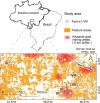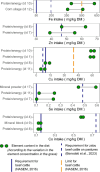Micronutrients and Toxic Elements in Soil, Grass, and Nutritional Supplements and in Blood and Meat Products from Beef Cattle Raised in the Southern Amazon, Brazil
- PMID: 40493031
- PMCID: PMC12203612
- DOI: 10.1021/acs.jafc.4c12513
Micronutrients and Toxic Elements in Soil, Grass, and Nutritional Supplements and in Blood and Meat Products from Beef Cattle Raised in the Southern Amazon, Brazil
Abstract
The objectives of this study were to investigate the transfer of micronutrients and toxic elements from the environment to animals and food and to obtain information about trace element levels in pasture-based animal production systems. Samples of soil, grass, nutritional supplements, and blood were obtained from different farms in the southern Amazon, Brazil. In addition, samples of muscle, kidney, and liver were obtained from various markets in the same region. All samples were analyzed to determine the concentrations of several elements: Fe, Mn, Zn, Cu, Se, Co, Mo, Ni, Cr, Pb, As, Cd, and Hg. Low concentrations of these elements were detected in soil and grass samples. Deficient or excessive concentrations of several micronutrients were detected in the nutritional supplements. Marginal Se deficiencies were identified in cattle blood. Meat products had low concentrations of Pb, As, Cd, and Hg and were considered rich sources of micronutrients, particularly of Fe, Zn, Se, and Cr in the muscle, Cu and Mo in the liver, and Se in the kidney. Information about the levels of micronutrients and toxic elements in animal production systems, such as pasture-based systems, can support strategies that promote sustainable farming and environmental, animal, and human health.
Keywords: farm; livestock; mercury; one health; pasture; selenium.
Figures









References
-
- McTavish, M. J. ; Cray, H. A. ; Murphy, S. D. ; Bauer, J. T. ; Havrilla, C. A. ; Oelbermann, M. ; Sayer, E. J. . Chapter 4 - Sustainable Management of Grassland Soils. In Soils and Landscape Restoration; Elsevier, 2021; pp 95–124. 10.1016/B978-0-12-813193-0.00004-7. - DOI
-
- Motta-Delgado P. A., Ocaña-Martínez H. E., Rojas-Vargas E. P.. Indicadores Asociados a La Sostenibilidad de Pasturas. Cienc. Tecnol. Agropecu. 2019;20(2):387. doi: 10.21930/rcta.vol20_num2_art:1464. - DOI
-
- Barbour R., Young R. H., Wilkinson J. M.. Production of Meat and Milk from Grass in the United Kingdom. Agronomy. 2022;12(4):914. doi: 10.3390/agronomy12040914. - DOI
-
- Doyle P., O’Riordan E. G., McGee M., Crosson P., Kelly A. K., Moloney A.. Temperate Pasture- or Concentrate-Beef Production Systems: Steer Performance, Meat Nutritional Value, Land-Use, Food–Feed Competition, Economic and Environmental Sustainability. J. Agric. Sci. 2023;54(3):1–16. doi: 10.1017/S0021859623000540. - DOI
MeSH terms
Substances
LinkOut - more resources
Full Text Sources
Medical
Research Materials

